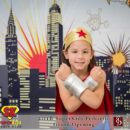Head Lice are Back to School too!
September 20, 2016Each year, in the United States, millions of children get infested with head lice. Though it can be very stressful, head lice don’t cause serious illness or carry any diseases.
What are head lice?
Lice are small wingless insects that measure 2-3 mm long (size of a sesame seed). They can be found on the head, eyebrows, and eyelashes of people, and attach their eggs to the base of the hair shaft. Head lice feed on small amounts of human blood, and live very close to the scalp. They usually survive less than a day if not on a person’s scalp.
These lice developed resistant to the chemicals used in most over-the counter lice treatments called pyrethroids (including permethrin).
How to Prevent?
Teach your kids to avoid sharing hats, brushes, or clothing. If a family member has contracted lice, make sure to check all household members and close contacts.
What to do?
Multiple head lice medications are available “over-the-counter”(OTC), without the need of a prescription from your Pediatrician. If you suspect that contracted lice could be a Super Lice because OTC treatments failed, visit your Pediatrician. She might consider a prescription medication. Wash in hot water all bed linens, clothes and toys. Dry clean or toss in hot dryer items that can’t be washed, or seal in a plastic bag for 2 weeks. Vacuum thoroughly. Soak combs and brushes in hot water (at least 130° F) for 5-10 minutes.
A good lice comb is important for manual removal of nits. Metal combs appear to be sturdier and stand up better to cleaning. Light colored combs allow for better visualization.
There are some home remedies that can be tried a well. Remember, “natural” doesn’t always mean safe or effective. Products to try should provide toll-free numbers and a list of product ingredients. Oil-based products (such as Olive Oil, Mineral Oil, Vaseline, Mayonnaise, Vinegar, Cetaphil or Listerin) appear to work by clogging up the breathing pores of the lice. These products are hard to remove from the hair and few scientific studies have been conducted that show these treatments to be effective.
Cutting or shaving a child’s head to get rid of head lice will work, but it may be at a high emotional cost to the child and is NOT necessary.
Consult a health care provider before treatment if you are a pregnant woman or nursing mother, have a neurological condition, have skin conditions such as psoriasis or open sores, have cancer, asthma or allergies, or if you have an allergy or sensitivity to ragweed or chrysanthemums and roses.
Products containing Lindane should be used with extreme caution. Consult a Pediatrician.
Myth or fact?
- Head lice can jump and fly from one person’s head to another’s. MYTH: Head lice move by crawling; they can’t jump, hop or fly.
- My daughter can get head lice from sharing a jacket with her friend who has them. FACT: Lice can also be spread by sharing clothing (hats, coats, scarves) or other articles worn or used by a person infested with head lice (brushes, towels, stuffed animals), and, by laying on a bed, pillow, couch, carpet that has been recently in contact with an infected person.
- Head Lice is associated with a risk of developing blood diseases. MYTH: Head lice will not place your child’s at risk of health problem.
by Lizaida Medina Candelaria, MD FAAP
Dr. Medina is a Board Certified Pediatrician and an active member of the American Academy of Pediatrics and Palm Beach Pediatric Society. Her office, SuperKids Pediatrics, is located in Palm Beach Gardens.
info@skpediatrics.com / 561-619-2460 / www.skpediatrics.com / www.facebook.com/skpediatrics





